A Pilgrim’s Progress: Following the Pilgrimage Route to Saint-Jacques-de-Compostelle
Ready to embark on the next chapter in his life, Daniel Kearney sets off on the Chemin du Puy pilgrim’s route to Saint-Jacques-de-Compostelle in search of a new direction
For twenty years I had a role, an identity, a label, a job. But after taking early retirement from teaching, I found myself looking for a reinvention of sorts. I needed to re-adjust to a different rhythm of life. One day, reading an article by Bruce Chatwin one line in particular caught my eye: “The best thing is to walk.” Movement is the best cure, he argued – for everything. Not taking flight, but moving purposefully, virtuously, in another direction, opening oneself up to new experiences. So I decided to walk. John, a friend who was also looking for a new direction, suggested the Via Podiensis, the pilgrimage route that starts at Le Puy-en-Velay and heads west towards Santiago de Compostela (Saint-Jacques-de-Compostelle in French). And so, we set off for Auvergne to begin our journey.
It was a steep climb up the crudely-cobbled rue des Tables and then up several flights of steps to the Cathédrale Notre-Dame du Puy-en-Velay for the 7am Pilgrims’ Mass and official start of our pèlerinage. At least 100 pilgrims, of all ages and nationalities, congregated in the chill morning air. There is a revival underway worldwide, with pilgrim numbers continually rising year on year, as people go in search of something the mainstream Church no longer seems able to provide. After our solemn blessing, we hurried to the sacristy to purchase the all-important Credencial, the pilgrim’s passport, which is stamped by whoever’s residence you spend the night at along the way, as an abiding record of your pilgrimage.
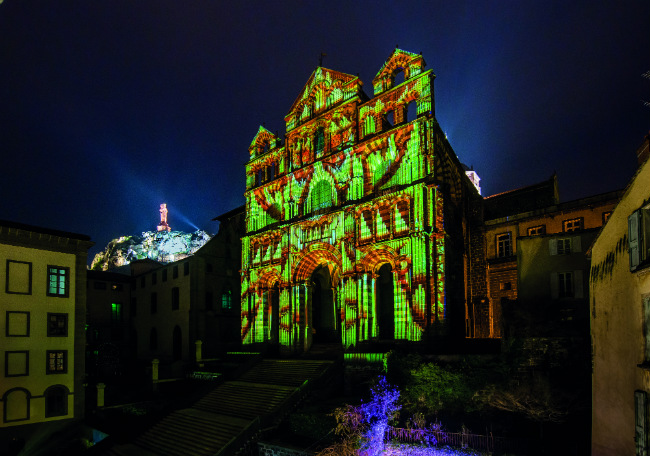
Puy de Lumières, a city- wide light show that ran in summer 2017. Photo: Luc Olivier
We booked our night’s accommodation at Monistrol-d’Allier, in Haute-Loire, about 30km away. Most pilgrims stop, wisely, at Montbonnet or Montbonnet, but not this intrepid duo! In the gathering gloom a heavy deluge fell as we plunged down the valley into Saint-Privat. Reluctantly we had to throw ourselves on the mercy of the owner of our hotel for the night and ask him to pick us up. It was not a promising start to our pilgrimage.
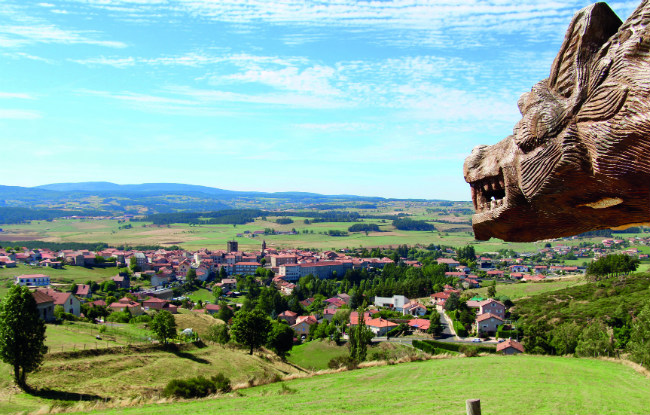
Saugues, a meeting point for pilgrims coming from the Auvergne. Photo: Fotolia
The following morning, in dampened clothes and spirits, we headed for Saugues. On entering we were greeted, disturbingly, by an impressive wood carving of La Bête du Gévaudan, the man-eating wolf or wolf dog that terrorised the former province of Gévaudan between May 1764 and June 1767. The beast, according to legend, was responsible for the deaths of between 80 and 113 people. The creature preyed, almost entirely, on women and children living in isolated cottages and hamlets, often as they tended animals or gathered crops in open fields. A local farmer, Jean Chastel, claimed to have shot and killed the beast in 1767 with a silver bullet fashioned from a medal of the Virgin Mary. With that reassuring thought in mind, we marched on to Saint-Alban-sur-Limagnole.
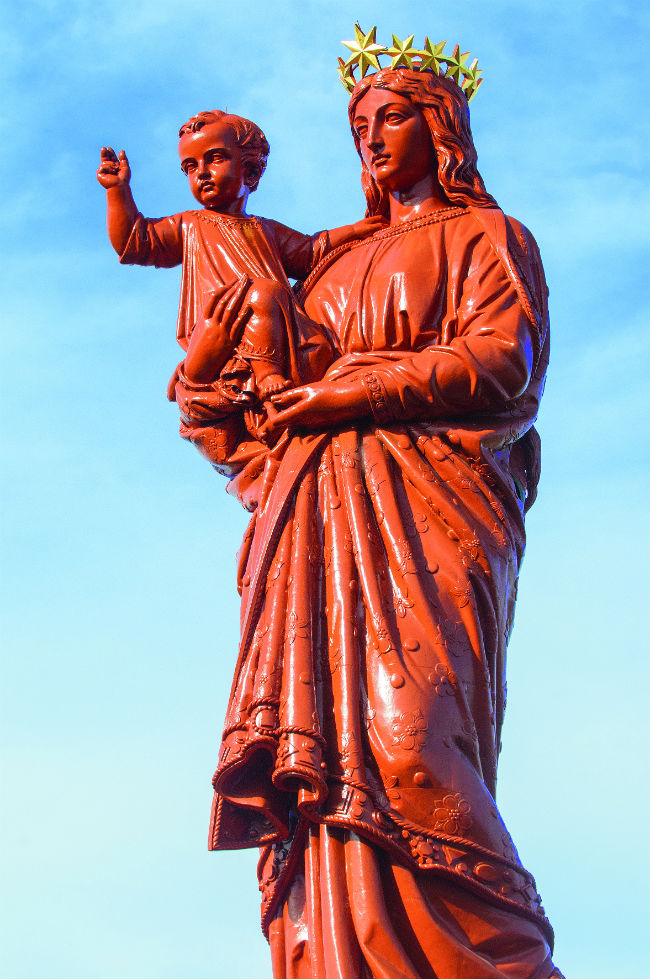
Statue overlooking Le Puy-en-Velay
THE PILGRIM’S DISCOUNT
If something appears too good to be true then it is. The hotel at Saint-Alban did not look like the place for two wet and grubby-looking backpackers. John assured me he had booked in on a “pilgrim’s discount” but I had my doubts, which were further strengthened when the obsequious owner greeted us with two flutes of champagne. In my limited experience of staying in such establishments, rooms that have names and not numbers invariably cost money, and plenty of it.
We tucked into a gargantuan feast, with the pièce de résistance the most tender and succulent côte de bœuf I have ever eaten. The owner suggested we finish with a digestif and poured out two whopping glasses of cognac from the most ornate bottle I have ever seen. All that was missing was a couple of cigars, but perhaps, understandably, these were not included on the pilgrim’s discount ticket!
Next morning, John burst into my room in an agitated and angry manner, firing off a string of invective, all aimed at the proprietor. The devious devil had charged us three times more than the quote. We went back to have it out with him. “The price was for the meal and not the room, or breakfast, or the digestif,” he blithely remarked. “And what about the champagne?” I sneered. “Compliments of the house,” he retorted with a smug smile on his face.
“Trash him on social media,” I said – if we could ever figure out how to access it.
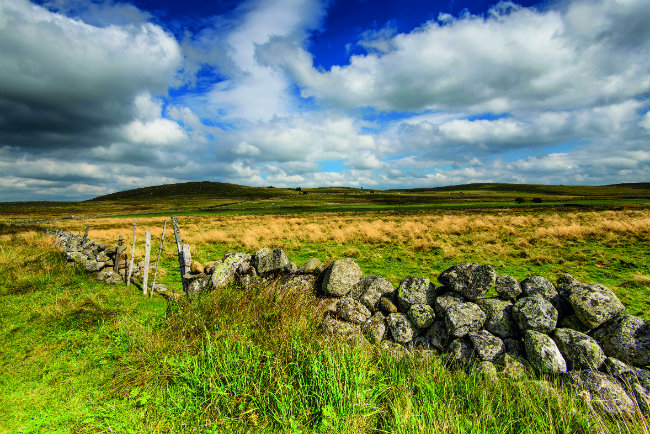
High on the Plateau de l’Aubrac. Photo: Fotolia
Barely recovered from our contretemps, we headed to Aumont-Aubrac in the Lozère department. The hamlet was once a strategic post, a busy crossroads of ancient routes between Auvergne and Lyon, and an important station on the Via Agrippa – the network of Roman roads running throughout Gaul, with its hub at Lugdunum, now modern-day Lyon. On the Aubrac, it is not a place to underestimate or take for granted. This vast, intimidating volcanic plateau spreads over three departments – Cantal, Aveyron and Lozère – and straddles three (former) regions, Auvergne, Midi-Pyrénées and Languedoc-Roussillon. It was rather tough-going, and our provisions of peanuts, chocolate and tins of tuna proved to be a wise purchase.
Other pilgrims were few and far between on the plateau, and all of them, like us, seemed to have one thing on their mind: getting through the day. As a long-distance cyclist I was well schooled in keeping my head down and pushing on. John too was a hardy soul. The ability to dig in and keep going is vital in a travelling companion, particularly on days like these. The final few kilometres of any stage are always the most gruelling and, paradoxically, the most exhilarating, as a heady blend of adrenaline and the anticipation of a hot shower and food kick in, powering on tired legs and backs to continue obediently to pull their weight.
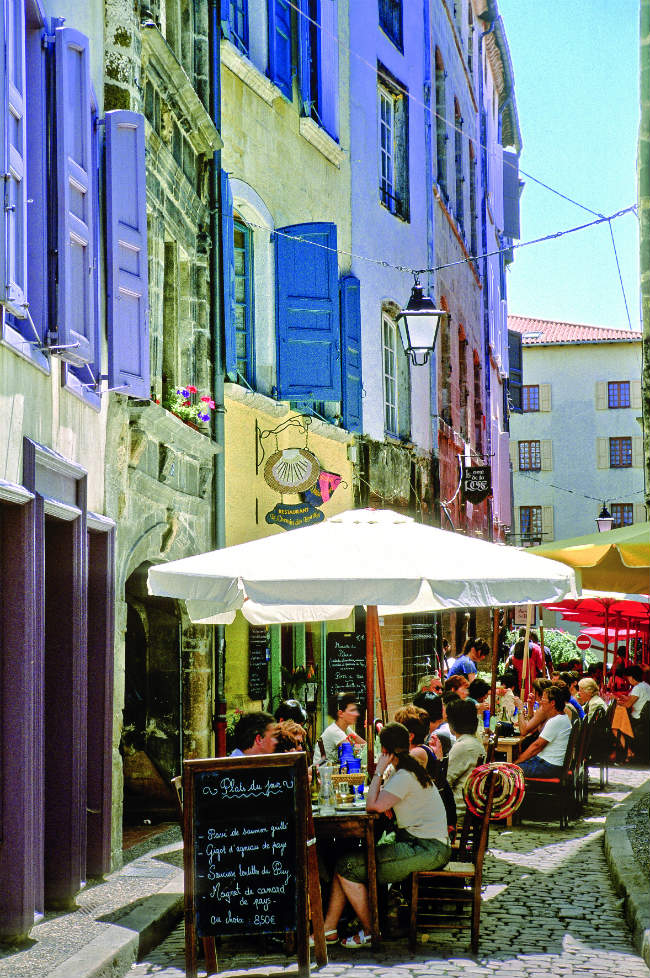
Rue Raphael in Le Puy-en-Velay
AN UPLIFTING SIGHT
After the austerity of the granite plateau, the village of Nasbinals, even in the gathering gloom, was an uplifting sight with its basalt houses and their flagstones roofs tightly huddled around the impressive 11th-century Romanesque Église Sainte-Marie and its eye-catching octagonal bell tower. The Hôtel de France, adjacent to the church, was our accommodation for the night. It was obvious from the memorabilia and photographs adorning the walls that we were in profound rugby country, and le patron had the cauliflower ears and girth of a former prop forward.
The whole section of the Chemin de Saint-Jacques-de-Compostelle from Nasbinals to Saint-Chély-d’Aubrac is a designated UNESCO World Heritage Site, a place for the soul to soar, a raw, exposed and wild paradise. In The Old Ways: A Journey on Foot, Robert Macfarlane wrote that, “For pilgrims walking… every footfall is doubled, landing at once on the actual road and also on the path of faith.”
I had a sense of this as we stood on the 14th-century Pont des Pèlerins, the pilgrims’ bridge at Saint-Chély, with its weathered carving of a medieval pèlerin wrapped in a cloak with the enduring symbols of a staff in one hand and a rosary in the other. I felt the tingle of a nerve in my spine as I contemplated the steps I too was taking on my own path of faith.
On the hottest day so far, it took us the best part of four hours to reach the medieval village of Saint-Côme-d’Olt. We entered the old quarter through the once-fortified Théron gate and went on past the medieval and Renaissance house roofs, looking like the hulls of upturned ships. We found some shade among the narrow streets on a bench in front of the Gothic-styled church, took off our boots and prepared our tuna sandwiches. From the distance we had spotted the church’s distinctive, twisted spire. We crossed the river Lot and headed to Espalion, dominated by the historic castle of Calmont d’Olt. There was once a thriving leather trade here and you can see the old tanneries with their corbelled wooden balconies beside the river.
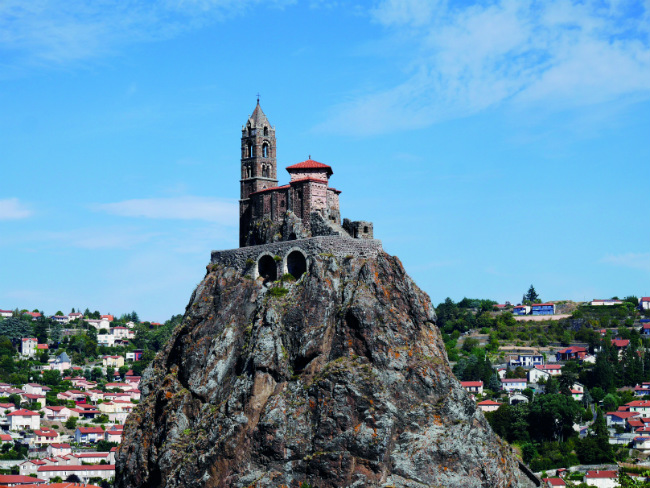
Saint Michel d’Aiguilhe chapel in Le Puy-en-Velay. Photo: Sean Cameron
The following morning we stopped for lunch at the stunning town of Estaing, with its Gothic bridge spanning the Lot and yet another impressive château. Such stops are always tinged with disappointment because you are aware that there is so much more to see but also mindful of the need to arrive in good time at that night’s accommodation. You cannot see everything! It was a relentless climb too, topping out at 700 metres, to Golinhac, but worth every step for the far-reaching views over the Lot valley.
Our first week finished, aptly enough, at the old medieval town of Conques, so named because of its surrounding, shell-shaped land – an appropriate feature too for the Chemin, where the cockle shell is an ever-present symbol. It is not difficult to see why Conques is described as “one of the great villages of southwest France”. The best view of the town is, ironically, looking back at it from the high vantage point of the Chapelle Sainte-Foy on the far side of the valley – a view only offered to those who, like us, still had a journey to make.
From France Today magazine
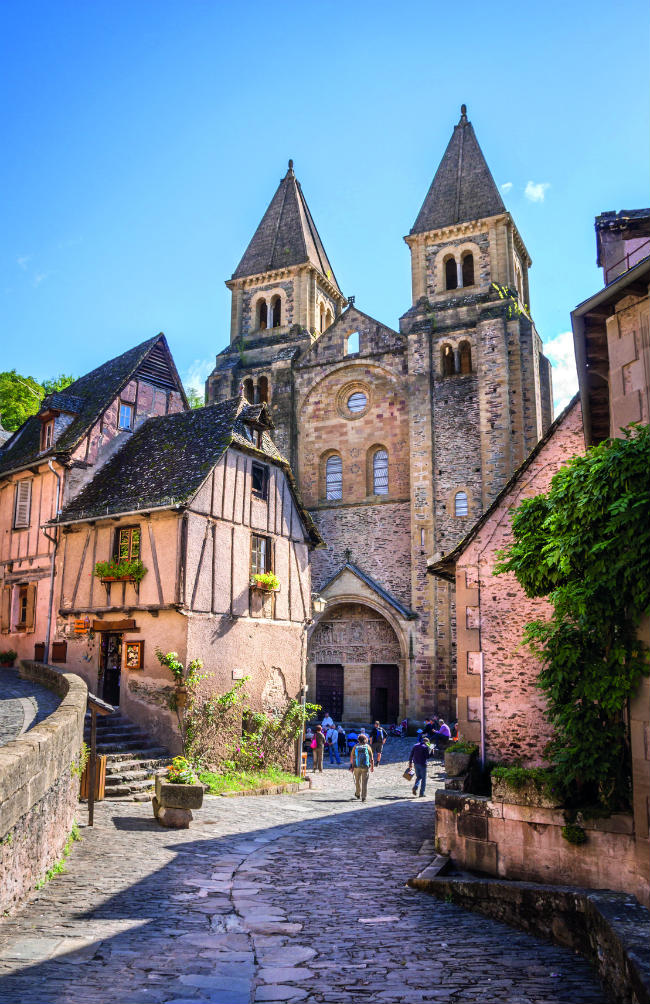
L’Abbaye Sainte-Foy de Conques. Photo: Fotolia
Share to: Facebook Twitter LinkedIn Email
Leave a reply
Your email address will not be published. Required fields are marked *

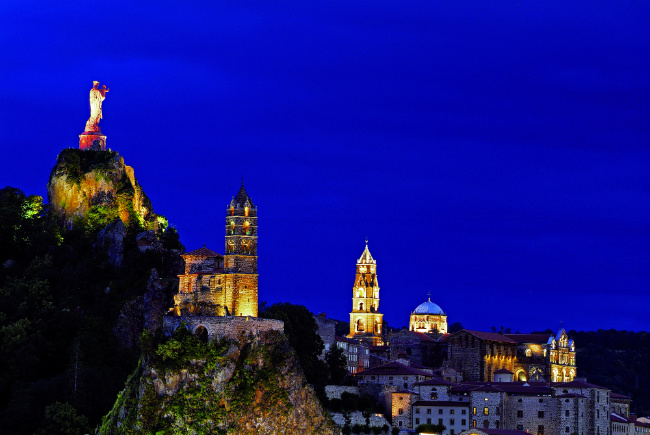




REPLY
REPLY